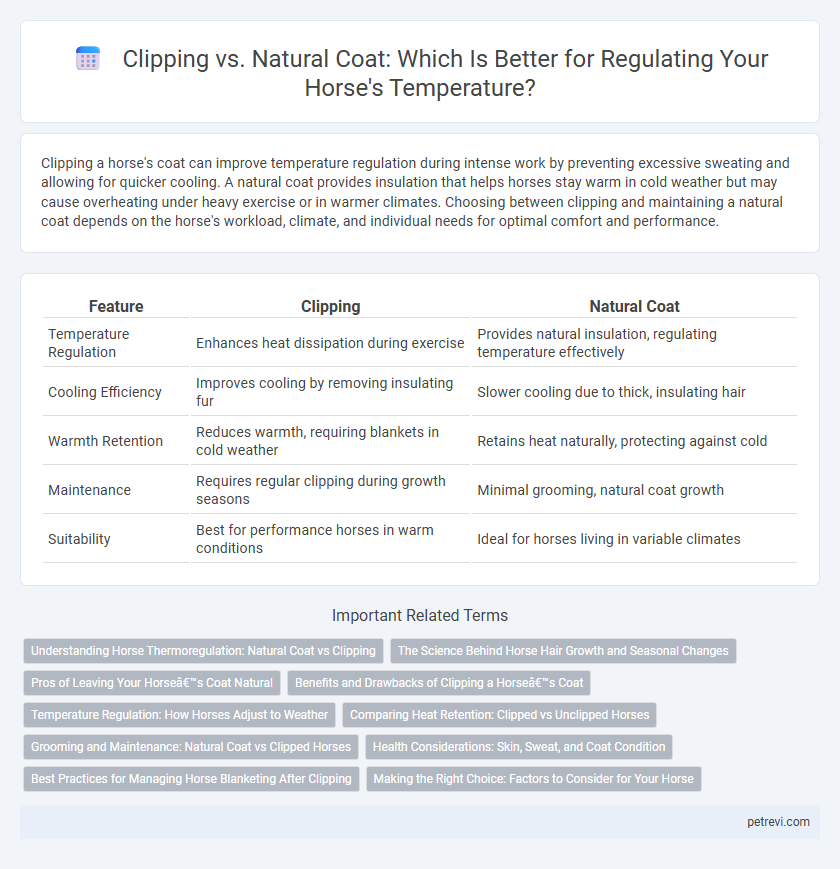Clipping a horse's coat can improve temperature regulation during intense work by preventing excessive sweating and allowing for quicker cooling. A natural coat provides insulation that helps horses stay warm in cold weather but may cause overheating under heavy exercise or in warmer climates. Choosing between clipping and maintaining a natural coat depends on the horse's workload, climate, and individual needs for optimal comfort and performance.
Table of Comparison
| Feature | Clipping | Natural Coat |
|---|---|---|
| Temperature Regulation | Enhances heat dissipation during exercise | Provides natural insulation, regulating temperature effectively |
| Cooling Efficiency | Improves cooling by removing insulating fur | Slower cooling due to thick, insulating hair |
| Warmth Retention | Reduces warmth, requiring blankets in cold weather | Retains heat naturally, protecting against cold |
| Maintenance | Requires regular clipping during growth seasons | Minimal grooming, natural coat growth |
| Suitability | Best for performance horses in warm conditions | Ideal for horses living in variable climates |
Understanding Horse Thermoregulation: Natural Coat vs Clipping
A horse's natural coat acts as an insulating barrier, trapping heat during cold weather and allowing cooling through sweat evaporation in warmer conditions, which supports optimal thermoregulation. Clipping removes this protective layer, reducing insulation and increasing reliance on artificial measures such as blankets or cooling techniques to maintain temperature balance. Understanding these physiological differences assists in making informed decisions about clipping based on climate, workload, and horse health.
The Science Behind Horse Hair Growth and Seasonal Changes
Horse hair growth is regulated by photoperiod and hormonal changes, primarily influenced by melatonin levels that trigger the development of a dense winter coat to provide insulation against cold temperatures. Clipping removes this natural barrier, potentially disrupting the horse's ability to regulate body temperature by exposing skin to environmental elements and requiring additional management to replace natural warmth with blankets or heated facilities. Understanding the science behind seasonal coat variations aids in optimizing horse care and maintaining thermoregulation efficiency throughout changing weather conditions.
Pros of Leaving Your Horse’s Coat Natural
Leaving a horse's coat natural enhances its ability to regulate body temperature through the natural insulation provided by the winter hair growth, which traps warmth while allowing sweat evaporation during exercise. The natural coat also provides protection against environmental elements such as UV rays and insects, reducing the risk of skin irritations and infections. Furthermore, maintaining the horse's natural coat supports the integrity of the skin's microbial balance, promoting overall health and resilience.
Benefits and Drawbacks of Clipping a Horse’s Coat
Clipping a horse's coat improves temperature regulation by preventing excess sweat accumulation and reducing drying time, which benefits horses in heavy work or damp climates. It can also minimize the risk of skin infections and promotes better hygiene. However, clipping removes the horse's natural insulation, increasing vulnerability to cold weather and necessitating blankets for protection.
Temperature Regulation: How Horses Adjust to Weather
Horses regulate their body temperature through their coat, which varies between natural and clipped states. A natural horse coat grows thicker in cold weather, providing insulation and trapping heat, while it sheds in warmer months to allow cooling through airflow and sweat evaporation. Clipped horses rely more on management practices like blanketing, as clipping removes the insulating fur, making them more vulnerable to temperature fluctuations during weather changes.
Comparing Heat Retention: Clipped vs Unclipped Horses
Clipped horses lose the insulating properties of their natural coat, resulting in reduced heat retention and increased vulnerability to cold temperatures compared to unclipped horses. Unclipped horses maintain a dense, natural coat that traps air, effectively preserving body heat and providing superior temperature regulation in cold environments. Proper management of clipped horses requires additional blanketing or shelter to compensate for their decreased thermal insulation.
Grooming and Maintenance: Natural Coat vs Clipped Horses
Natural coats provide horses with a self-regulating insulation system, requiring minimal grooming beyond regular brushing to remove dirt and loose hair. Clipped horses need more frequent grooming to prevent skin irritation and maintain coat health, especially after clipping disrupts their natural protection against weather conditions. Proper maintenance of clipped coats includes regular application of moisturizing products and appropriate blanketing to support temperature regulation.
Health Considerations: Skin, Sweat, and Coat Condition
Clipping a horse helps prevent excessive sweating and reduces the risk of skin infections by allowing moisture to evaporate quickly, promoting a healthier coat condition. A natural coat provides insulation, protecting the skin from cold and UV rays but may trap sweat, leading to bacterial growth and irritations. Regular grooming is essential for both clipped and natural coats to maintain skin health, prevent sores, and support optimal temperature regulation.
Best Practices for Managing Horse Blanketing After Clipping
Horse temperature regulation depends heavily on coat condition; clipped horses lose natural insulation and require careful blanketing to maintain warmth. Best practices for managing horse blanketing post-clipping include selecting breathable, waterproof blankets that match ambient temperatures and regularly adjusting layers to prevent overheating or chilling. Monitoring the horse's body condition and behavior ensures optimal comfort and health during temperature fluctuations.
Making the Right Choice: Factors to Consider for Your Horse
Choosing between clipping and maintaining a natural coat for your horse depends on factors such as climate, workload, and individual health. Horses in cold climates with frequent exercise may benefit from clipping to prevent overheating during work, while natural coats offer better insulation and protection in harsh weather. Assessing your horse's activity level, sweat management, and shelter availability ensures optimal temperature regulation and overall well-being.
Clipping vs Natural Coat for Horse Temperature Regulation Infographic

 petrevi.com
petrevi.com